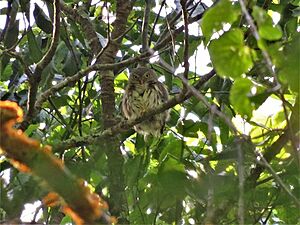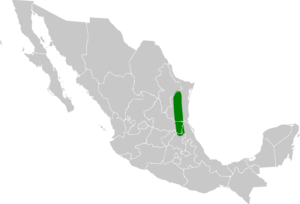Tamaulipas pygmy owl facts for kids
The Tamaulipas pygmy owl (Glaucidium sanchezi) is a small type of owl that belongs to the group called Strigidae. This special owl lives only in Mexico. It is one of the smallest owls in the world. It is about 13.5 cm (5.3 in) long. Even though it is tiny, it weighs a bit more than some other very small owls. This owl lives in warm, wet montane forests in tropical and subtropical areas.
Quick facts for kids Tamaulipas pygmy owl |
|
|---|---|
 |
|
| Conservation status | |
| Scientific classification | |
| Genus: |
Glaucidium
|
| Species: |
sanchezi
|
 |
|
| Distribution of Tamaulipas pygmy owl Resident | |
Contents
What the Tamaulipas Pygmy Owl Looks Like
Adult Tamaulipas pygmy owls are usually between 13 and 16 cm (5.1 and 6.3 in) long. They have a fairly long tail, about 5.1 and 5.7 cm (2.0 and 2.2 in). On average, they weigh about 53 g (1.9 oz). Male owls are often a little lighter than females.
Male and Female Owls
The male owl has a brownish face with small white spots. It also has short white eyebrows. Its upper body is olive-brown. The top of its head is greyer with tiny white speckles. The main feathers on its wings and tail have white stripes. Its belly and chest are whitish with some reddish-brown streaks and spots. Its legs are covered in feathers. It has a yellowish-brown beak and bright yellow eyes. The female owl looks similar to the male. However, she has more reddish-brown colors overall.
Where the Tamaulipas Pygmy Owl Lives
The Tamaulipas pygmy owl is found only in Mexico. It lives in the mountains of northeastern Mexico. You can find it in the northern part of the state of Hidalgo. It also lives in the southeastern part of the state of San Luis Potosí.
Owl's Mountain Home
This owl makes its home in wet evergreen forests. It also lives in montane forests and cloud forests. These are forests found high up in the mountains. The owl lives at altitudes between about 900 and 2,100 m (3,000 and 6,900 ft).
Life and Habits of the Tamaulipas Pygmy Owl
This owl is active during both the day and night. It hunts for its food. It eats insects and small animals like lizards.
Reproduction and Young Owls
We do not know much about how these owls raise their young. They usually choose a hole in a tree to make their nest. These holes were often made by a woodpecker before. The female owl lays up to four white eggs. The baby owls can fly soon after they leave the nest.
Protecting the Tamaulipas Pygmy Owl
The International Union for Conservation of Nature (IUCN) checks on how safe different animals are. They once thought the Tamaulipas pygmy owl was a "least concern" animal. This meant it was not in much danger.
Why the Owl is Now Near Threatened
However, its status has now changed to "near-threatened". This means it could become endangered soon. The forests where this owl lives are being cut down. Because of this, the owl's home is getting smaller. Scientists also think the number of these owls is going down. There are likely fewer than 50,000 of these birds left.


